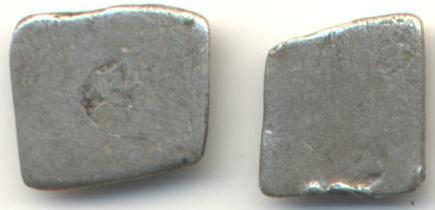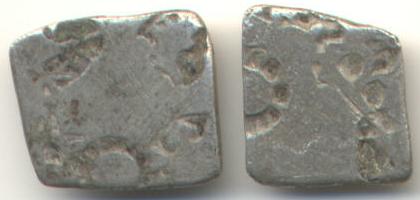3rd century BCE. - Lanka
Anuradhapura Period - `Purana' Coins
The earliest reference to the usage of coins in Lanka is found in the
Buddhist Literature which mentions types of coins issued in the 3rd
century BCE. These earliest known coins were small pieces of metal,
generally of silver, punched with a common Royal mark. The
metal were thereafter subjected to further punching with marks of
various institutions. These punched marked metal are referred to as
`purana' (Sanskrit for old) and Englished as `eldling'.
The eldlings were manufactured by subdividing bars of metal or strips
cut from a hammered sheet, the weight being adjusted where necessary
by clipping the corners of each coin so formed.
|
These archaic coins were probably issued by "local authorities -
money-changes or merchants" and were submitted by them for the
approval of the local king or governor, whose stamp appears on the
reverse. The marks on the reverse are usually fewer in number, in the
great number of cases one only, are less distinct, and frequently
smaller.
|

|
|
The obverse once blank, is usually covered with punch marks, often
overlapping and clearly impressed at different times by successive
money-changes whose hands they passed in the course of circulation.
No less than 189 different markings have been traced in the eldlings
found in various parts of Lanka. See display in Colombo Museum.
|

|
Text from
* Ceylon Coins and Currency By H. W. Codrington. Colombo 1924
Page 16 Chapter III Ancient Coins - Edlings - Plate 1
See also
* Ancient Ceylon By H. Parker, London, Luzac & Co, 1909
Chapter XII "The Earliest Coins", Page 459, and Fig 154 that faces Page 469.
The silver coins were scanned at 300dpi and displayed at 300dpi.
These two coins were purchased in 1998 from a shop in Fort, Colombo.
They were part of a large hoard found in Sri Lanka.
Apparently most had been melted by the ignorant finder. A few
had been rescued by the shop to which they had been brought for the
manufacture of Jewelry.

